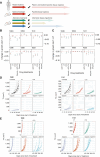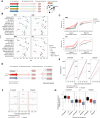Modeling Drug Responses and Evolutionary Dynamics Using Patient-Derived Xenografts Reveals Precision Medicine Strategies for Triple-Negative Breast Cancer
- PMID: 39514406
- PMCID: PMC7617242
- DOI: 10.1158/0008-5472.CAN-24-1703
Modeling Drug Responses and Evolutionary Dynamics Using Patient-Derived Xenografts Reveals Precision Medicine Strategies for Triple-Negative Breast Cancer
Abstract
The intertumor and intratumor heterogeneity of triple-negative breast cancers, which is reflected in diverse drug responses, interplays with tumor evolution. In this study, we developed a preclinical experimental and analytical framework using patient-derived tumor xenografts (PDTX) from patients with treatment-naïve triple-negative breast cancers to test their predictive value in personalized cancer treatment approaches. Patients and their matched PDTXs exhibited concordant drug responses to neoadjuvant therapy using two trial designs and dosing schedules. This platform enabled analysis of nongenetic mechanisms involved in relapse dynamics. Treatment resulted in permanent phenotypic changes, with functional and therapeutic consequences. High-throughput drug screening methods in ex vivo PDTX cells revealed patient-specific drug response changes dependent on first-line therapy. This was validated in vivo, as exemplified by a change in olaparib sensitivity in tumors previously treated with clinically relevant cycles of standard-of-care chemotherapy. In summary, PDTXs provide a robust tool to test patient drug responses and therapeutic regimens and to model evolutionary trajectories. However, high intermodel variability and permanent nongenomic transcriptional changes constrain their use for personalized cancer therapy. This work highlights important considerations associated with preclinical drug response modeling and potential uses of the platform to identify efficacious and preferential sequential therapeutic regimens. Significance: Patient-derived tumor xenografts from treatment-naïve breast cancer samples can predict patient drug responses and model treatment-induced phenotypic and functional evolution, making them valuable preclinical tools.
©2024 The Authors; Published by the American Association for Cancer Research.
Conflict of interest statement
Y. Eyal-Lubling reports grants from European Union’s Horizon 2020 Research and Innovation Program under the Marie Sklodowska-Curie grant agreement No 895808 during the conduct of the study. G. Lerda reports other support from Cambridge Commonwealth, European, and International Trust during the conduct of the study. S. Wix reports grants from the Fulbright U.S. Student Program and Cambridge Trust during the conduct of the study. E. Provenzano reports personal fees from Roche and AstraZeneca and other support from IBEX Analytics outside the submitted work. K. McAdam reports personal fees from AstraZeneca and Pfizer outside the submitted work. C. Caldas reports grants and other support from AstraZeneca during the conduct of the study and other support from Illumina and grants from Genentech, Servier, and Roche outside the submitted work. No disclosures were reported by the other authors.
Figures






References
-
- Perou CM, Sorlie T, Eisen MB, van de Rijn M, Jeffrey SS, Rees CA, et al. . Molecular portraits of human breast tumours. Nature 2000;406:747–52. - PubMed
-
- Dvinge H, Git A, Gräf S, Salmon-Divon M, Curtis C, Sottoriva A, et al. . The shaping and functional consequences of the microRNA landscape in breast cancer. Nature 2013;497:378–82. - PubMed
MeSH terms
Substances
Grants and funding
- CRUKE/14/048 (A20735)/Cancer Research UK (CRUK)
- A16942/Cancer Research UK (CRUK)
- 16942/CRUK_/Cancer Research UK/United Kingdom
- 29567/CRUK_/Cancer Research UK/United Kingdom
- DMPAXBAAF/Institute of Cancer Research (ICR)
- MC_UU_00002/16/Medical Research Council (MRC)
- BRC-1215-20014/NIHR Cambridge Biomedical Research Centre (NIHR Cambridge BRC)
- A29580/Cancer Research UK Cambridge Institute, University of Cambridge (CRUK CI)
- 895808/HORIZON EUROPE Marie Sklodowska-Curie Actions (MSCA)
- ERC-2015-AdG-694620/HORIZON EUROPE European Research Council (ERC)
LinkOut - more resources
Full Text Sources

